Programming Note: Because of the Thanksgiving holiday, TechByter Worldwide will take a break next week, thereby giving you something else to be thankful for.
Adobe CS4: The Preview
The Adobe juggernaut continues. I'll have to check, but I'm fairly certain that "juggernaut" is not a term that I have ever used in the 15+ year history of this program. That alone may say something about what will follow. Adobe has recently released Creative Suite 4 and, for the past couple of weeks I've been trying to devise an analysis and review process that will do justice to a series of applications that range from publication design (InDesign and Acrobat) and photo editing (Photoshop) to sound editing (Soundbooth) and video editing (Premier and After Effects). I'll also want to examine what's new in the vector graphic program (Illustrator) and the website development tools (Dreamweaver, Flash, and Fireworks) as well as various other components that are included in the package.
ALL ARTICLES IN THIS SERIES
I will add links to this sidebar as I complete reviews.
Introduction, Installation, and Bridge
Photoshop
InDesign and InCopy
Dreamweaver
Acrobat
Soundbooth and Audition
Adobe's video applications
Flash and Fireworks
Illustrator
The only way I could accomplish this review in a single episode would be to extend TechByter Worldwide to an all-day program. What I'll do is select one component to highlight on each of several programs over the next couple of months. As much as I would like to do it sooner and faster, there just isn't any way for one person to review this many complex applications, and do it right, on an accelerated schedule.
Why a Mud House?
In doing a bit of research I learned why Adobe is called Adobe. I had always wondered why two guys from the Xerox Palo Alto Research Center would name their company after mud houses. As it turns out, that's not where the name comes from. Adobe Creek ran behind John Warnock's house in Palo Alto. Warnock and Charles Geschke founded the company in December 1982. They had developed the PostScript page description language, the foundation on which all modern publishing is based.
The Past is Prologue
Adobe acquired Aldus, the company responsible for PageMaker and After Effects, in 1994. In 1999, Adobe acquired GoLive systems and launched its version of GoLive to compete with Macromedia's Dreamweaver website development suite. Then Adobe acquired Macromedia in 2005 to bring the best website development tool in house. Prior to that, Adobe had picked up Syntrillium Software and its Audition program, which led to Adobe Soundbooth. Soundbooth doesn't replace Audition, but it's a program with fewer features, one that lends itself to use by people who aren't audio production professionals.
Adobe is now well positioned with products for every kind of media: Audio, video, Web, and print.
Click any of the small images in this article for a full-size view.
Adobe Bridge
 CS4 is available in 3 versions: Design Premium (Web, audio, video, and print), Production Premium (audio, video, and print) and Web Premium (Web components). Regardless of which package you select, you will receive Adobe Bridge. Photographers may choose to use Adobe Lightroom 2 in place of Bridge, as I noted in a Lightroom review, but Bridge is there if you need it, and you will because there are features in Bridge that aren't available in Lightroom 2.
CS4 is available in 3 versions: Design Premium (Web, audio, video, and print), Production Premium (audio, video, and print) and Web Premium (Web components). Regardless of which package you select, you will receive Adobe Bridge. Photographers may choose to use Adobe Lightroom 2 in place of Bridge, as I noted in a Lightroom review, but Bridge is there if you need it, and you will because there are features in Bridge that aren't available in Lightroom 2.
In about half an hour, Adobe's Julieanne Kost reveals Bridge's new features on Adobe TV. At right, above, is one of many digital image views available in Bridge.
The development team's primary goal with CS4 was to make Bridge easier to use, not to add new features, but one of the nicest new features is the ability to create a Web gallery or a PDF document (essentially a contact sheet) of your photos. In testing, I created a Web gallery from some pictures that I made this fall at several Metro Parks.
Another major enhancement is speed. Bridge is now faster and supports directories with hundreds, or even thousands, of images without gasping. On your first pass through a group of new photos, you may be looking primarily for composition so that you can cull the clearly unacceptable images. In this case, you can tell Bridge to give preference to speed over image quality. Later, when you've narrowed the field, you can begin to assess the quality of individual images.
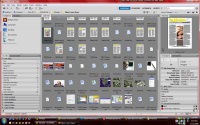 Bridge's search function now works with Spotlight (on the Mac) or Desktop Search (Windows) and it allows you to create what are essentially virtual directories that contain images from several physical directories. This is essentially a database application because Bridge simply creates pointers to the original files and stores them as "collections".
Bridge's search function now works with Spotlight (on the Mac) or Desktop Search (Windows) and it allows you to create what are essentially virtual directories that contain images from several physical directories. This is essentially a database application because Bridge simply creates pointers to the original files and stores them as "collections".
In addition to digital image files, Bridge can also display and organize files from other Adobe applications. At the right, above, you'll see a view that shows Adobe InDesign documents.
Installation Problems
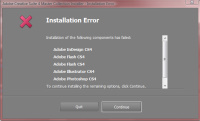 I always seem to have problems installing Adobe applications. Maybe it's just me. When I tried to install under Vista, I got an installation error.
I always seem to have problems installing Adobe applications. Maybe it's just me. When I tried to install under Vista, I got an installation error.
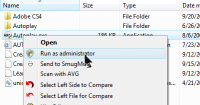 The next step with Vista always involves running as Administrator, even though my account has administrator privileges.
The next step with Vista always involves running as Administrator, even though my account has administrator privileges.
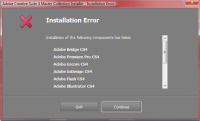 That didn't work, either. (At right)
That didn't work, either. (At right)
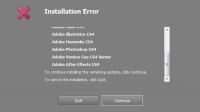 So then I tried running the actual installer file instead of the autorun file as administrator. Same thing (left).
So then I tried running the actual installer file instead of the autorun file as administrator. Same thing (left).
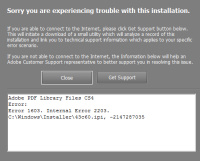
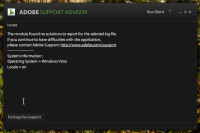 The installer application tried to offer help, but never was able to provide any real assistance.
The installer application tried to offer help, but never was able to provide any real assistance.
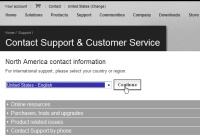 There was no information on the Adobe website that resolved the problem, either, so I called Adobe support.
There was no information on the Adobe website that resolved the problem, either, so I called Adobe support.
Adobe's support is usually good and this was no exception. The first person I spoke with gathered enough information to determine what the primary problem was, then directed me to a technician. I explained the steps that I had taken and the technician, understanding that I could handle the troubleshooting on my own, provided a clear, concise set of instructions.
Installing CS4 might not have required all of the following steps, but I decided to go for a one-shot fix rather than sneaking up on the solution. I copied the installation files to the hard drive, created a new user name called "Adobe Installer" (with administrator privileges), rebooted the machine and logged on as Adobe Installer, and ran the installation program. Problem solved.
Did You Get Your Stimulus Check?
With the economy in shambles, every crook and his brother seems to be running a phishing scam. This week I received one from the "IRS" telling me about an economic stimulus check that I had to register for. The first clue I had that this might be bogus, other than knowing that the IRS isn't sending out any economic stimulus payments at the moment, was the fact that the e-mail came from a domain in Canada and the IRS is located in Washington, DC.
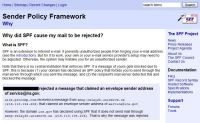 The message was flagged by Sender Policy Framework (SPF) because "the domain irs.gov has declared using SPF that it does not send mail through smtp-relay2h.uniserve.ca (216.113.194.206)." SPF is an extension to Internet e-mail. It prevents people from forging an e-mail address by allowing users to specify the IP address of their SMTP server. If a message claims to be from the IRS and it's not from the right IP address, it's assumed to be fraudulent.
The message was flagged by Sender Policy Framework (SPF) because "the domain irs.gov has declared using SPF that it does not send mail through smtp-relay2h.uniserve.ca (216.113.194.206)." SPF is an extension to Internet e-mail. It prevents people from forging an e-mail address by allowing users to specify the IP address of their SMTP server. If a message claims to be from the IRS and it's not from the right IP address, it's assumed to be fraudulent.
No central institution enforces SPF, but the IRS had specified its IP address and, when the message arrived from smtp-relay2h.uniserve.ca (216.113.194.206), it was rejected.
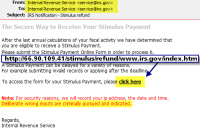 The message told me "After the last annual calculations of your fiscal activity we have determined that you are eligible to receive a Stimulus Payment. Please submit the Stimulus Payment Online Form in order to process it. A Stimulus Payment can be delayed for a variety of reasons. For example submitting invalid records or applying after the deadline. To access the form for your Stimulus Payment, please click here Note: For security reasons, we will record your ip-address, the date and time. Deliberate wrong inputs are criminally pursued and indicated."
The message told me "After the last annual calculations of your fiscal activity we have determined that you are eligible to receive a Stimulus Payment. Please submit the Stimulus Payment Online Form in order to process it. A Stimulus Payment can be delayed for a variety of reasons. For example submitting invalid records or applying after the deadline. To access the form for your Stimulus Payment, please click here Note: For security reasons, we will record your ip-address, the date and time. Deliberate wrong inputs are criminally pursued and indicated."
Clicking the link would have taken me not to the IRS, but to this URL:
http://xx.90.109.41/stimulus/refund/www.irs.gov/index.htm (I have obscured the real IP address, but you can see it in the image above.)
![]() By the time I got around to checking the URL, it had already been taken down.
By the time I got around to checking the URL, it had already been taken down.
The IP address belongs to FSTCS dot COM, which may or may not have anything to do with the phish. It's possible that someone simply stored rogue code in the subdirectory, but the fact that the root directory isn't accessible isn't a particularly good sign.
The site is hosted in Chicago by FDCservers.net, a company that apparently acted quickly to take down the bogus site.
An Uncommonly Stupid Phish
Sometimes I receive a phish that is so astonishingly stupid that all I can do is stare at it in disbelief. That happened on Thursday of this week when a spam-phish arrived from the "United Postal Service", a company that does not exist.
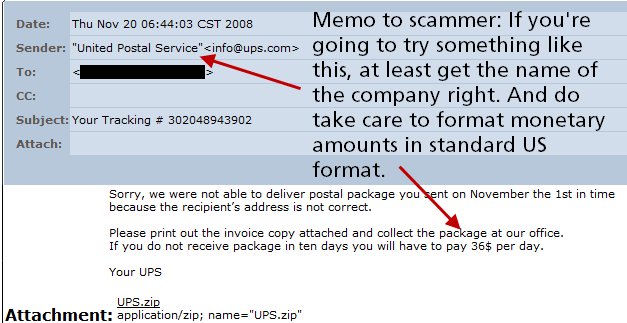
Except for the stupidity shown by misunderstanding the difference between United Parcel Service and the United States Postal Service, the spam was largely unremarkable.
Well, maybe a couple of things:
- Neither the US Postal Service nor the United Parcel Service would show 36 dollars as "36$" because in the United States, we place the currency symbol to the left of the number.
- No UPS tracking number ever has or ever will be in the format shown.
- Both the USPS and UPS are relatively large organizations and, if you are supposed to pick up your package at their office, it's likely that they will tell you which of their thousands of offices your package is at.
- The wording is clearly that of someone who does not speak English as a first language. Do you know any native American who would say "Please print out the invoice copy attached and collect the package at our office"?
I don't know what was in the Zip file because I didn't download it or open it. The most likely contents would be a file that masquerades as a PDF or DOC file, but that is actually an executable file with a payload I wouldn't want.
Nerdly News
Feeling Sorry for Jerry Yang (Almost)
Just a few months ago, Jerry Yang could have said "OK" and sold Yahoo to Microsoft. Most of the stockholders seemed to want the deal to go through, but Yang didn't. He refused Microsoft's offers and then, with Yahoo's share price around 1/3 of what Microsoft offered, he said that the best deal for Microsoft would be to buy Yahoo. That deep rumbling chuckle you heard from the northwest was Microsoft. No deal. No way. Then Yang announced that he would step down as CEO.
Yahoo stock rebounded by about 9% the next day, only to fall back to where it had been a day later.
So now Yahoo has no CEO, companies have pulled back on advertising, and Yahoo's revenue is continuing to fall. In general, Yahoo has failed to keep up with the market it was instrumental in creating. Meanwhile, Google has become the search engine of choice. Yahoo hasn't done much with its photo sharing website (Flickr) and isn't in the social networking site at all.
There's some speculation that Microsoft will eventually own Yahoo, but at fire-sale prices. The company still has value. It probably does make sense for Microsoft to acquire the company, but at more like $10 per share or less instead of $33 per share.
For Paper, Ink, Press, and the USPS, The End Approaches
Well, maybe not exactly the end. But if you're selling paper, ink, or presses to newspaper and magazine publishers, you're in about the same position as the manufacturers of harnesses in the early 1900s. If you were paying attention, you could see your business had a limited future. The Christian Science Monitor will lead the way among newspapers in dropping its print version. For magazines, the high-profile leader (to nobody's great surprise) will be PC Magazine. For several years, the magazine has made most of its profits from Web operations and the magazine has been largely an afterthought. The January issue will be the last PC Magazine will print.
Advertising revenue is down. Costs of ink, paper, press operators, and postage are all up. A Web-only version eliminates all of those costs and leaves only the writers and designers. PC Magazine is ahead of the curve because it is already essentially a Web operation. Other magazines still get most of their money from selling physical magazines. The formula will change for other magazines, too; just not as quickly.
Other smaller publications have already announced an end to print editions, but PC Magazine is by far the largest and most visible magazine to make the move. Print subscriptions are down. In the late 1990s, circulation hit 1.2 million issues, but now the magazine's advertising base rate is about half that. As a result, ad rates are down and, exacerbating the problem, the number of advertisers is declining, too.
End of the Road for Transmeta
Chip maker Transmeta was one of the promising stories that I followed for several years. The company was always at PC Expo in New York City with its low-energy PCs that could run significantly longer than Intel or AMD processors on a single battery charge and its server blades that were far more power efficient than those from the big guys. But the CPU never caught on and now Novafora will buy Transmeta for $256 million.
In the mid 1990s, Transmeta and its Crusoe chip was a serious rival to Intel's Pentium. The company was backed by financier George Soros. Microsoft co-founder Paul Allen was involved. And Linus Torvalds, the guy responsible for Linux, worked there for a while. For the past several years, Transmeta hasn't developed or sold CPUs; instead, the company has done little more than license its intellectual property to its former competition.
Novafora is a semiconductor company without a plant or a product. Maybe by next year it will make its first digital video microprocessors and it apparently sees some value in the work Transmeta has done on Crusoe. The goal, according to Novafora, is to develop a processor that requires much less power to run than anything currently on the market.
The Weekly Podcast
Podcasts are usually in place no later than 9am (Eastern time) on the date of the program. The podcast that corresponds to this program is below. The most recent complete podcast is always located here.
Search this site: Looking for something you remember hearing about on TechByter Worldwide? Search me.
Subscribe to the newsletter: Subscribing to the podcast: I recommend Apple's Itunes for podcasts. Itunes will also install the latest version of QuickTime. The program is free. Need instructions?
Privacy Guarantee: I will not sell, rent, loan, auction, trade, or do anything else with your e-mail address. Period.
How the cat rating scale works.
Do you use a pop-up blocker? If so, please read this.
The author's image: It's that photo over at the right. This explains why TechByter Worldwide was never on television, doesn't it?
Feed the kitty: That's one of them on the left. Creating the information for each week's TechByter requires many hours of unpaid work. If you find the information helpful, please consider a contribution. (Think "NPR".)


